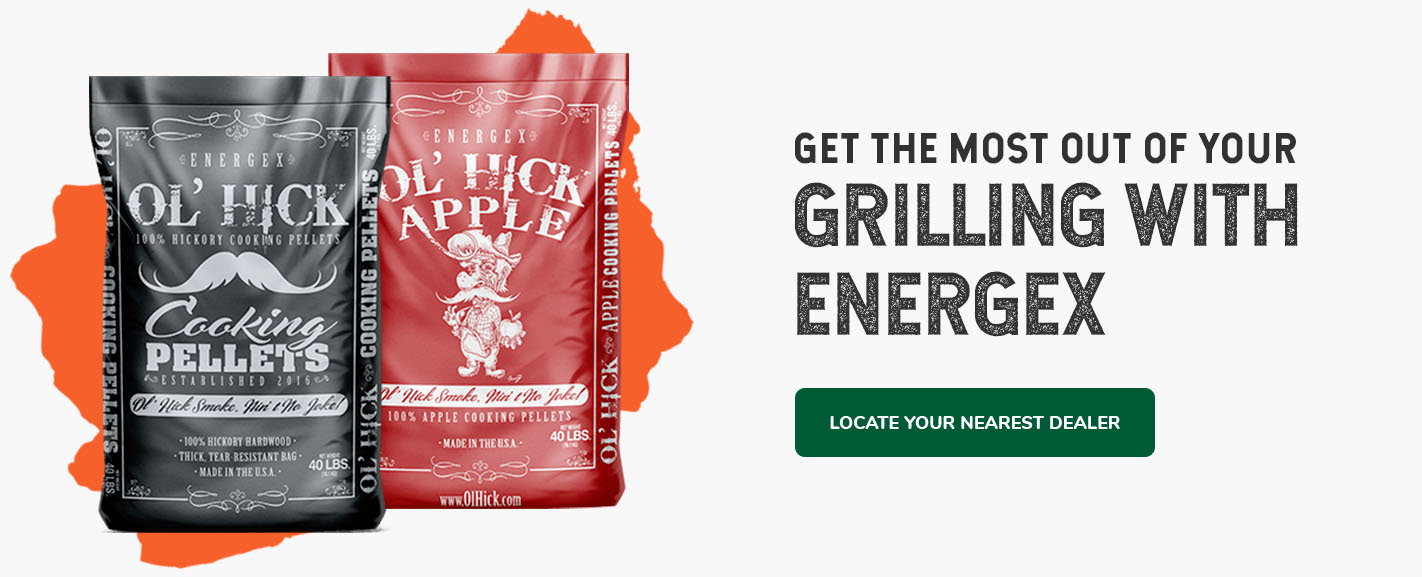Types of Grills and Grill Cooking Styles
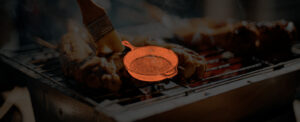
One of the best parts of summer is the chance to whip out your grill and enjoy everything that outdoor cooking has to offer. Cooking the juiciest, tastiest and most delectable meals on your grill means knowing what type of grill you need and understanding how to use different grill cooking styles to your advantage. This is the ultimate guide to help you on your grilling journey.
What Are the Different Types of Grills?
What’s the best type of grill for you? If you’re looking to purchase a new grill, take a comprehensive look at the different types of grills and smokers, what they do well, how they’re used and their potential limitations to help make your decision easier.
1. Charcoal Grills
Charcoal grills are the most popular type of grill and are what most people associate with grilling itself. Charcoal grills are one of the best outdoor grills because they’re easy to use and produce a lot of smoke, making them more suited for outdoor cooking.
Beginners can easily handle charcoal grills once they get a handle on how to start the fire properly and how to control the temperature using vents and dampers. The first step to getting this right is knowing what parts make up a charcoal grill.
- Firebox: The firebox holds the charcoal and the flame and is located at the base of the grill.
- Vents: The vents are at the top and bottom. They’re used to adjust the airflow and control the temperature of the fire and the inside of the grill.
- Lid: The lid of a charcoal grill has an adjustable vent that helps control the cooking temperature. You can also use the lid to keep the smoke in and give your food that delicious smokey taste.
- Cook chamber: The cook chamber is what the grill grates sit on. The grill grates position your food slightly above the flame burning in the firebox below.
Charcoal grills are the most well-known types of grills for a reason. There is a lot that makes them the quintessential outdoor cooking tool, but some drawbacks might make you consider another type of grill. Let’s look at the pros and cons of this grill style.
Pros
Charcoal grills reach higher temperatures compared to gas grills — it’s easy for a grill with burning red charcoals to reach 700 degrees Fahrenheit. The charcoal grill is also one of the best grills for achieving the perfect smokey flavor. This is generally one of the less expensive styles of grills and can be bought for anything from $25, making it easy to find the perfect one that suits your grilling needs.
Cons
A downside to using a charcoal grill is its time to heat up. On average, you can expect to wait between 15 and 20 minutes to reach the right cooking temperature, whereas other grill options can reach it instantly. Charcoal prices can quickly add up depending on how much you use your grill, as well. A 20-pound bag of charcoal may last for three uses. Additionally, when you’re done grilling, a lot of ash must be emptied and scrubbed off your grill before you can put it away.
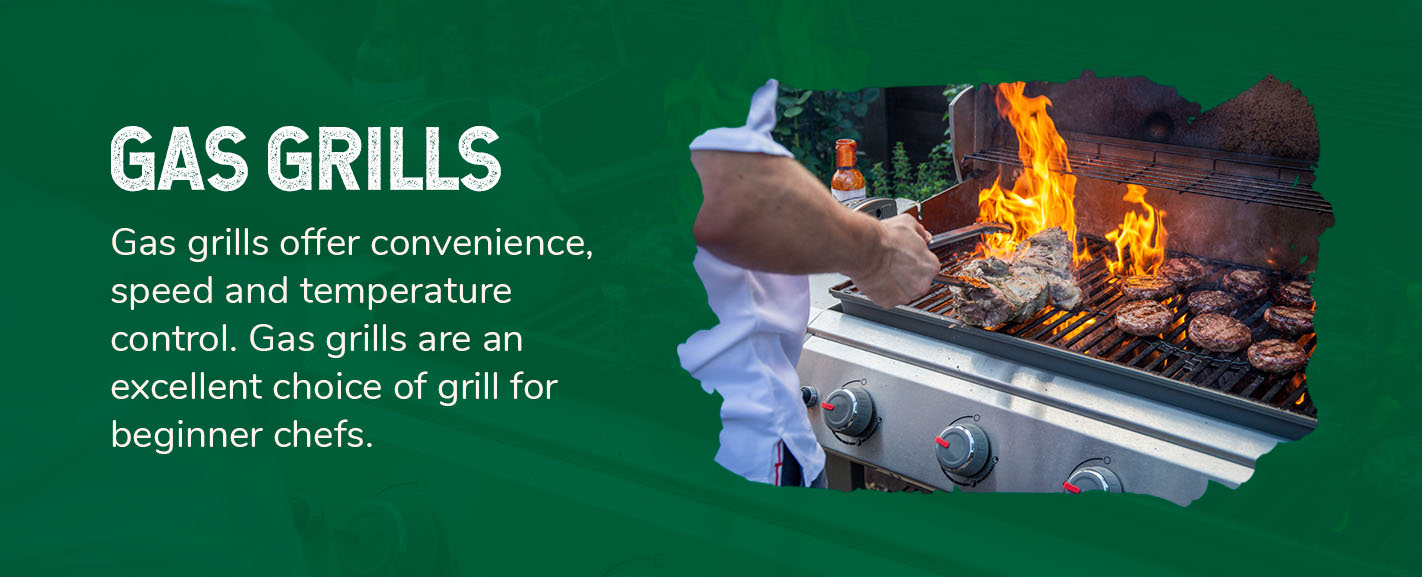
2. Gas Grills
Gas grills offer convenience, speed and temperature control. Gas grills are an excellent choice of grill for beginner chefs as a result. There is a lot that makes a gas grill great, but there are some factors you should keep in mind when deciding what type of grill is best for you.
Pros
Temperature control on a gas grill is done with a simple turn of a dial, making it one of the easiest grills to use. You can easily cook a wide range of meats with this feature, from ribs that need low heat to steaks that cook at searing hot temperatures.
Speed is another advantage of the gas grill. Just press the ignition button for a quick and easy startup after a short preheat, and you can start cooking immediately. A 20-pound propane cylinder will give you 25 days of cooking time, potentially making this a more fuel-efficient option than some other grills.
Cons
Hooking up your gas grill to a propane tank can be a time-intensive project. The more complicated and sophisticated your gas grill is, the longer this process might take.
Additionally, you must follow safety precautions to use a gas grill safely. Gas is a dangerous substance if you don’t handle it with care, and making sure your grill is properly connected to a propane tank with no leaks is vital before starting up your gas grill.
3. Electric Grills
Electric grills are safe, easy-to-use outdoor grills that don’t need a propane tank, fire starter or charcoal to cook. By using electricity, this grill has no flame, making it safer to operate, and there’s no need to worry about wind and rain extinguishing anything. This is another reliable grill type for beginners to use, with many features that could make it a good option for you.
Pros
This is one of the most convenient grills you can have. It’s easy to travel with, as no other fuels or resources aside from electricity are required to cook with it. On top of that, there’s no carbon buildup after use, making clean-up simpler.
Much like gas grills, electric grills have precise temperature control features that are straightforward to use. Electric grills are well-suited for delicate cooking, too. Lean meats, fish and vegetables can be done to perfection with this style of grill.
Cons
While electric grills are portable and easy to move around with, they can only be set up near electrical outlets. This limits you to locations equipped for them, so they can’t be used in any park or beach. They’re also vulnerable to power outages and surges, which can damage them and end your grilling session.
Electric grills have a lot of moving parts that make them costly to repair should they get damaged. Moving parts are also more susceptible to wear and tear. Control units, thermostats and heating elements are some parts that might be damaged over time.
Lastly, electric grills are efficient at cooking, but their counterparts are better at drawing out the different flavors of your food.
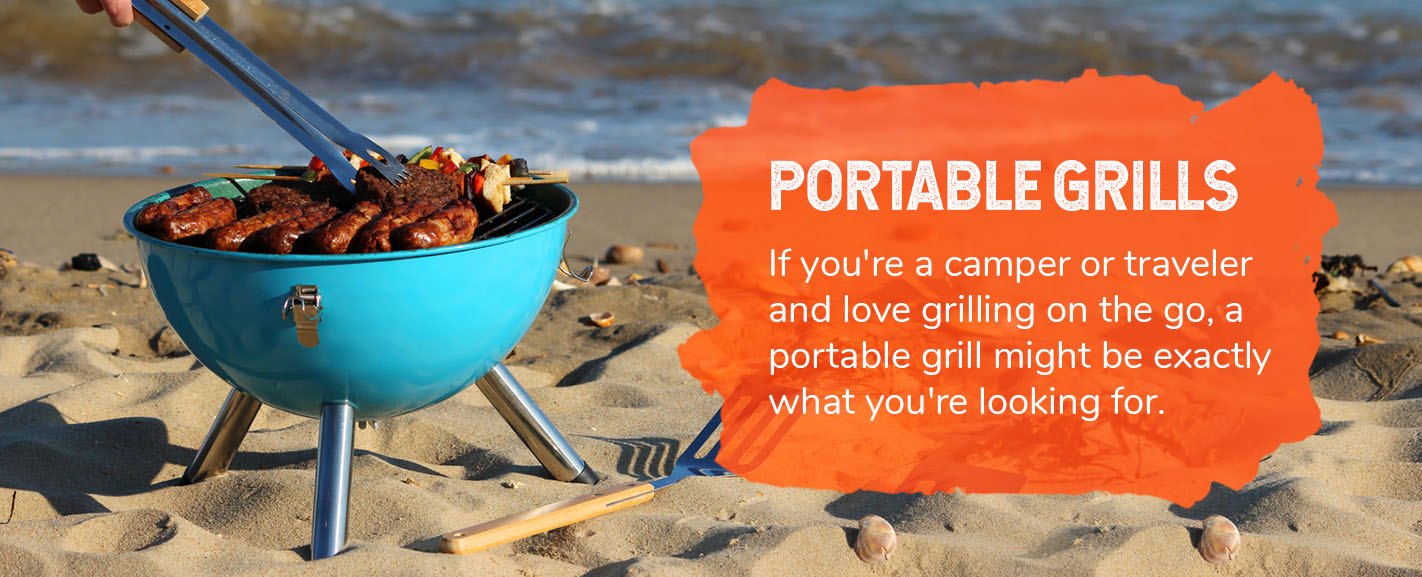
4. Portable Grills
Portable grills are ideal for people who want to grill on the road and in places other than their backyards. If you’re a camper or traveler and love grilling on the go, a portable grill might be exactly what you’re looking for.
Pros
Their durability makes it easy to use them anywhere and transport them without worrying about damage, and they’re also easy to store. Portable grills are small and compact and are ideal for grilling alone or with just a few other people.
Cons
Portable grills produce low heat compared to other grills. Their small size limits what they can do, making it difficult to use them efficiently to feed many people. Their design and compact size also greatly hinder their ability to smoke meat properly, making them a less-than-ideal option if that’s your goal.
5. Indoor Grills
Indoor grills are the best solution for grilling enthusiasts living in apartments without balconies or backyards. Filling your kitchen and apartment with smoke is avoidable with this handy grill type. There are three main kinds of indoor grills:
- Grill pans: These are specialized types of pans shaped like a typical grill grid, giving you the authentic grill experience on your stove.
- Griddles: A griddle is a wide, flat-surfaced grill that can be used to cook eggs, omelets, pancakes and small grill meals. A griddle’s smooth service and shallow depth make it well-suited for grilling food that’s easy to flip.
- Open grills: Open grills are counter-sized grills that can give you the standard outdoor grilling experience indoors. Some are designed to contain heat and smoke, like outdoor grills.
Overall, indoor grills are easy to clean and often affordable, but you won’t get the same flavors from these grills as you would using others. Additionally, their small cooking surfaces mean you can’t prepare lots of food at once.
6. Wood Pellet Grills and Smokers
When you want to add new, rich flavors to your grilling, there’s no option better than a wood pellet grill and smoker. Wood pellet grills are versatile outdoor grills with precise temperature controls and are ideal for high-temperature grilling and low-temperature smoking.
Wood pellet grills use hoppers to feed wood pellets into the fire to add flavors, develop rich tastes and enhance anything you want to grill, bake, barbecue, roast and smoke. When the hardwood pellets are added to the fire, they emit a specialized flavorful smoke that seeps into the food in your grill or smoker.
Due to the precise temperature control options and flavor-enriching features, there’s a lot that makes wood pellet smokers and grills a desirable choice for any grill and food lover to consider. This type of grill is innovative and uncomplicated for anyone to use. Some grills even allow you to control them through a smartphone app that lets you adjust the temperature, monitor smoking, control the grill and more, giving unmatched precision.
Further, a variety of flavors can be added to your meal. Wood pellets come in all sorts of flavors and can make a huge difference to the taste of your food. Hickory, apple and bourbon are only a few examples of flavors and styles of barbecue wood pellets. Plus, wood pellets are made of renewable resources, making them more environmentally friendly than other grill fuels like charcoal and gas.
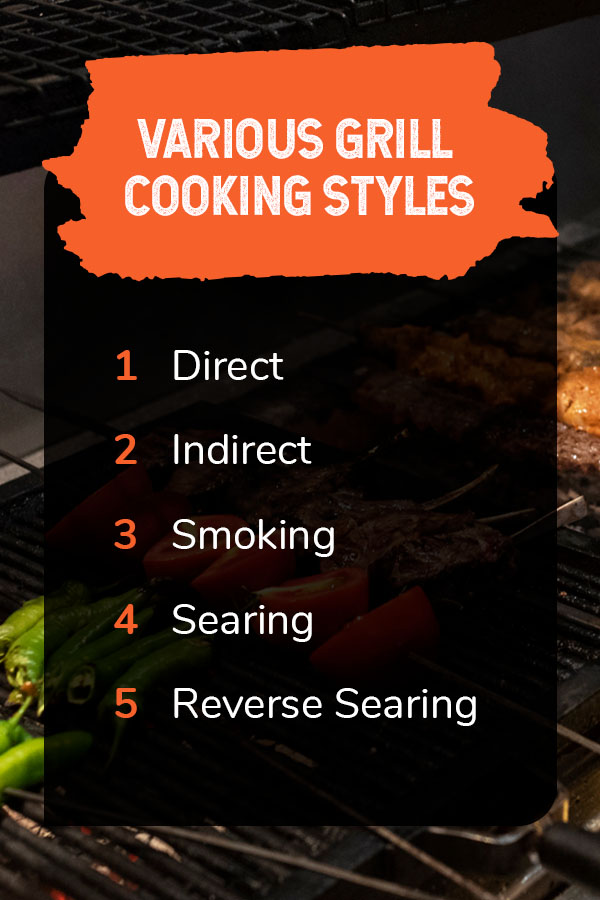
Various Grill Cooking Styles
Whether you’re just starting to explore grilling or consider yourself a seasoned expert, you may be curious about the kinds of grilling styles that exist. With the right techniques under your belt, you can grill your favorite foods to perfection. Here are five common styles of grilling:
1. Direct
The typical style of grilling foods directly above the fire or heat source is known as direct grilling. Direct grilling can get the job done in minutes once your grill reaches the right temperature. This style is perfect for crisping and searing your ingredients.
The best way to set up direct grilling is to:
- Preheat: Preheating the grill until it’s no longer smoking is the optimum time for direct grilling. Be sure to turn the heat down to medium or medium-high if you’re using a grill with temperature control features.
- Remove debris: To get the most out of your direct grilling experience, ensure the grill is clean and free of debris.
- Season the cooking grids: Use oil to prevent sticking while you grill. Food sticks to dry grates, so remember to do this.
- Flip: Flipping lets you add sear marks to your food in different directions. A crisscross sear mark pattern produces the best steaks.
2. Indirect
Indirect grilling is when your food is cooked on a grill rack above the heat source, usually with the lid closed. This grill cooking style works like an oven, where your food is steadily cooked from all sides at lower temperatures. Indirect grilling is the best approach to cooking large meals and tougher food like brisket, ribs, whole chicken and whole turkeys.
Here are some indirect grilling tips:
- Two-zoned grilling: This is the most common way to achieve this cooking style. This is when the heat source is on one side of the grill, and the food is on the other.
- Indirect heat: The best way to achieve indirect heat is to place the charcoal on half the grill or light your burners on only one side of your grill.
- Ring of fire: Line the perimeter of your grill with the heat source and place your food within that ring so that it receives heat at various angles.
3. Smoking
Smoking is when you cook “slow and low” over indirect heat for several hours. This draws out flavors and gives your meal a smokey taste. Using cooking wood pellets allows you to add flavors and different smokey tastes to your meal and is what makes smoking such a popular grilling style.
Here are some top tips to get the most out of your smoking style:
- Clean your smoker: Smoking in a dirty grill with leftover residue creates creosote-filled smoke, which is dangerous.
- Trussing: Trussing is when you tie your meat with string to help it keeps its shape and lets it cook evenly.
- Light blue smoke: The best color smoke for smoking is light blue. Black or gray smoke means your wood is starved of air. Unpleasant flavors come from dark smoke, whereas light blue smoke creates the best flavor.
- Use the right wood pellets: Cooking wood pellets offer different flavors to your food when smoking. Be sure to use the ones that add the flavors you like the most.
4. Searing
Searing is when you start cooking your meat at a high temperature to sear the surface and lower the temperature to finish cooking it. Prime ribs, pork, steak and chicken benefit the most from this grill cooking style.
One kind of searing is charring, which is when the heat breaks down the surface of the meat and leaves behind carbon. Charring occurs at temperatures above 500 degrees Fahrenheit or when you overcook your meat. Some charring is inevitable, and a small amount is fine and won’t affect your flavor.
When done right, searing can greatly enhance your meal, but you’ll want to take care to ensure you don’t char your entire meal.
5. Reverse Searing
Reverse searing is when you cook your meat in the oven or on an indirect heat source, and then complete the cooking process on the grill. Like searing, this is a great way to add flavor to your meal, but it also helps make your meat more tender and juicy. The best part about reverse searing is that it makes it much easier to cook your meat evenly and avoids many common grilling mistakes.
To reverse sear properly, manage your timing and preheat the oven and grill for at least 30 minutes before starting each phase. Aim for temperatures between 400 and 500 degrees Fahrenheit on your grill, depending on whether you use high or medium-high heat.
Get the Most out of Your Grilling With Energex
Energex sells quality cooking pellets to ensure the food you grill has unbelievable flavors. Ol’ Hick Cooking Pellets contain 100% hickory wood and have no artificial flavors to ensure you get the genuine taste of hickory in your grill. We also carry apple- and bourbon-flavored cooking pellets that provide truly unique flavors for grilled meats and vegetables.
Locate your nearest dealer to start grilling with our BBQ wood pellets!


